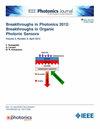基于用户年龄的大昼夜节律作用因子三原色激光显示屏光谱优化
IF 2.1
4区 工程技术
Q3 ENGINEERING, ELECTRICAL & ELECTRONIC
引用次数: 0
摘要
为了研究既能提供光生物安全水平高的光源,又适合不同年龄用户的激光显示屏,本研究从峰值波长和辐射通量的分数出发,对三原色激光显示屏的光源进行了优化。利用基于遗传算法的非线性程序,将色域覆盖率设定为 90%以上,相关色温设定为 6500K。在小于 D65 光源对 1 岁儿童造成的蓝光危害(BLH)的前提下,寻找合适的峰值波长和辐射通量分数,并选择昼夜节律作用因子(CAF)最大的结果作为各年龄段的优化结果。同时,本研究还探讨了峰值波长和最佳结果附近辐射通量分数的变化对不同年龄组昼夜节律作用因子和蓝光危害的影响。它为在日常工作环境中为不同年龄的用户设计健康考虑的激光显示器提供了参考。本文章由计算机程序翻译,如有差异,请以英文原文为准。
Spectral Optimization of the Three-Primary Laser-Based Displays With Large Circadian Action Factor Based on Age of User
To investigate the laser-based displays that can offer the light source with a high level of photobiological safety and are suitable for users of different ages, this research optimizes the light source of the three-primary laser-based displays from its peak wavelength and the fractions of radiant flux. The non-linear program based on genetic algorithm is used to set the color gamut coverage over 90% and the correlated color temperature at 6500K. Find suitable peak wavelength and fractions of radiant flux with the premise of less than the blue light hazard (BLH) caused by the D65 light source to the 1 year, and select the result with the maximum circadian action factor (CAF) as the optimization for each age. Meanwhile, this research explores the effect that a change in the peak wavelength and fractions of radiant flux near the optimal results on CAF and BLH in different age groups. It provides reference for the design of health consideration laser displays for different age users in the daily working environment.
求助全文
通过发布文献求助,成功后即可免费获取论文全文。
去求助
来源期刊

IEEE Photonics Journal
ENGINEERING, ELECTRICAL & ELECTRONIC-OPTICS
CiteScore
4.50
自引率
8.30%
发文量
489
审稿时长
1.4 months
期刊介绍:
Breakthroughs in the generation of light and in its control and utilization have given rise to the field of Photonics, a rapidly expanding area of science and technology with major technological and economic impact. Photonics integrates quantum electronics and optics to accelerate progress in the generation of novel photon sources and in their utilization in emerging applications at the micro and nano scales spanning from the far-infrared/THz to the x-ray region of the electromagnetic spectrum. IEEE Photonics Journal is an online-only journal dedicated to the rapid disclosure of top-quality peer-reviewed research at the forefront of all areas of photonics. Contributions addressing issues ranging from fundamental understanding to emerging technologies and applications are within the scope of the Journal. The Journal includes topics in: Photon sources from far infrared to X-rays, Photonics materials and engineered photonic structures, Integrated optics and optoelectronic, Ultrafast, attosecond, high field and short wavelength photonics, Biophotonics, including DNA photonics, Nanophotonics, Magnetophotonics, Fundamentals of light propagation and interaction; nonlinear effects, Optical data storage, Fiber optics and optical communications devices, systems, and technologies, Micro Opto Electro Mechanical Systems (MOEMS), Microwave photonics, Optical Sensors.
 求助内容:
求助内容: 应助结果提醒方式:
应助结果提醒方式:


